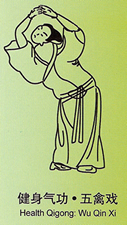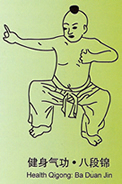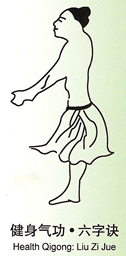Frequently Asked Questions
Please check out our branches to find out whether there is an instructor near you.
|
All our instructors are trained, examined and certified according to the technical standards as set out by the national
Chinese Health Qigong Association (CHQA), China. Instructor Workshops are held on a regular basis by delegated Master Instructors of CHQA.
If you are interested in becoming an instructor or wish to study Health Qigong please enquire at our head office for the next available workshop.
|
QiGong (pronounced Cheegong) originated in ancient China and is deeply rooted in the traditional Chinese culture.
Its functions vary in different traditional Chinese cultural schools.
Confucians practice qigong to cultivate mind and body, Taoists and Buddhists do it to transcend worldliness,
Chinese medical physicians us it to cure illness and keep healthy and martial artists practice it to defend themselves and fight against attacks.
Qigong (also Chi Kung) is a psychosomatic exercise skill that adjusts body,
breath and mind into one. Qi refers to internal or vital energy and gong to a skill that requires time and effort.
The first adjustment is to align the body posture and movement, the second is to adjust the breath and the third is to adjust mental activities.
By integrating the 'three adjustments into one' the special psychosomatic state of qigong practice is formed.
Qigong is a skill-training process and its mastery mainly depends on scientific methods,
a thorough understanding of the integrated state of adjusting body, breath and mind which is developed through persistent regular practice.
|
There are a great variety of Qigong practice forms, however all consist of body, breath and mind adjustments.
The different qigong practice forms vary in the contents and combinations of the three adjustments,
but for all 'three adjustments into one' is necessary.
The healthy qigong systems practiced by us are inherited from the national Chinese Health Qigong Association, China,
which conducted a thorough nationwide research into ancient traditional Chinese exercise and health improvement systems,
resulting in the development of four types of health qigong, namely the 'Five Animal Exercises' (Wu Qin Xi),
the 'Tendon Muscle Strengthening Exercises' (Yi Jin Ying), the 'Six Sounds Approach to Breathing Exercises' (Liu Zi Jue),
and 'Eight Section Exercises' (Ba Duan Jin).
The development of the four types of health qigong follows the approach of a scientific research project directed by related scientific theories
such as Traditional Chinese Medicine (TCM), modern medicine, psychology, science, physical culture and sports,
by absorbing the essence of related qigong schools and the wisdom of multiple experts and scholars.
As these four qigong types are scientific, easy to learn and practice, beautiful in movements yet rich in contents and obvious in
health improving results, health qigong enthusiasts welcome them worldwide.
|
Health Qigong Exercise Series is compiled by the national Chinese Health Qigong Association (CHQA),
which is dedicated to inheriting and developing the traditional health culture of China in promoting healthy qigong activities worldwide to serve
the purpose of improving human health.
Based on researching the traditional Chinese way of exercise for the purpose of improving health, four types of health qigong
were developed by conducting modern scientific research into scientific theories and fields like Traditional Chinese Medicine (TCM),
modern medicine, psychology, science of physical culture and sports as well as by absorbing the essence of related qigong schools
and the wisdom of expert practitioners and scholars.
|
CHQA in Beijing is dedicated to inheriting and developing the traditional health culture of China in promoting healthy Qigong activities
worldwide to serve the purpose of improving human health. The four types of health Qigong developed by
CHQA are Tendon-Muscle Strengthening Exercises (Yi Jin Jing), Five Animal Exercises (Wu Qin Xi), Eight Section Exercises (Ba Duan Jin),
and Six Sounds to Breathing Exercises (Liu Zi Jue) are briefly described below.
|

The earliest description of Yi Jin Jing exercises can be found on a 2000 years old brocade painting named 'Illustration of Qi Circulation' (Dao Yin),
which was unearthed in the 1970s from an ancient tomb in Changsha, Hunan, China. From 526 AD on,
monks of the Shaolin Monastery played an important role in the evolution of the Yi Jin Jing exercises.
The earliest account of the modern 12-movement exercises is included in the Illustrations of Internal Exercise compiled by
Pan Wei in 1858 in the Qing Dynasty.
As traditional Yi Jin Jing relies heavily on the traditional Chinese medicine theory of the Five Elements - metal, wood, water, fire, earth - different
school of the exercises have evolved, emphasizing this aspect in many works.
The Health Qigong Yi Jin Ying absorbed the cream of the traditional 12-routine Yi Jin Ying exercises together with a modern scientific approach.
The movements form a continuous integrity, focusing on tendon stretching and bone flexing and combining softness with strength.
An essential part of the routines is natural breathing and the integration of mind and body with a relaxed spirit to make the circulation of
the vital energy (qi) as unimpeded as possible.
Yi Jin Jing movements require a full range of stretching, bending, flexing and twisting in multi-directional and wide-ranging motions of the bones
and related joints. As the bones are flexed, the muscle groups, tendons and ligaments are also stretched.
This improves the blood circulation, nutrition supersession in the soft tissues of the motion-related areas, increases the flexibility and
pliability of such soft tissues as muscles, tendons, ligaments and enhances the mobility of the bones, joints and muscles.
The exercises are centered on the twisting, flexing, and stretching of the spine, with the waist as the axis and are conducted at
a slow and even pace. Such movements help to stimulate spinal and nerve cords to make them function more effectively,
together with the exercise of limbs and internal organs. Strength, when required, is applied in a gradual manner and the muscles
should be relaxed to combine strength with tenderness.
The Yi Jin Ying movements have been proven to be able to improve health, fitness, prevent diseases, lengthen life and improve intellect.
Regular, correct practice has very impressive effects on the respiratory system, flexibility, balance and muscular strength.
It may also help to prevent and cure diseases of the joints, digestive, cardiovascular and nervous system.
|

The system of Five Animal Exercises were designed by Hua Tuo, a leading physician of the Eastern Han Dynasty (25-220 AD).
Hua Tuo developed this system based on existing ancient Chinese traditional exercises following theories of the functions of the internal organs
and meridians as well as the principles of the circulation of Qi and blood in the human body. His inspiration came from the careful observation
and study of the characteristic behaviour of tigers, deer, bears, monkeys and birds, concluding that wild creatures regularly performed certain
exercises to build up their constitution and improve their life skills.
The Five Animal Exercises imitate the movements of five animals and combining physical with mental exercises.
The physical movements are designed to show the courage and robustness of the tiger, serenity and poise of the deer,
the steadiness and solidity of the bear, the nimbleness and dexterity of the monkey and the swiftness and grace of the bird.
The physical movements are at all times integrated with the mental exercises which are supposed to imitate the spiritual activities and
expressions of the animals.
The exercises have the aim of strengthening muscles and bones, promoting the circulation of Qi and blood, preventing and curing diseases,
maintaining good health and prolonging the life span. The external dynamic physical activities should be integrated with the static activities
of the mind. Exercising limbs, waist, trunk and spine can increase the movement range and physical efficiency.
Exercises of the fingers and toes are particularly emphasized for improving the blood circulation to the extremities.
Physical and psychological tests of people practicing the Wu Qin Xi give high scores to their overall constitution, the functions of
the various organs, mental attitude and power of perception, as well as physical fitness.
The movements are simple and easy to remember as well as very safe and can be exercised by people of different age groups and stages of
practice.
|

The Eight-section Exercises date back to the Song Dynasty (960-1279) and its easy movements and impressive effects on health make it a gem
in China's health and fitness culture.
Purpose of the exercises is to increase internal energy circulation through spiritual cultivation and physical exercises so as to improve
health and fitness. Deep natural breathing is required during the practice of the routines, without any constraint.
It has been proved that practice of Ba Duan Jin improves the respiratory system, limb strength, flexibility of the joints,
fortifies the nerves as well as enhances the general balance. It improves the cardiovascular function and helps to cure such illnesses as
coronary artery scleroses and osteoporosis. It strengthens one's immune system to a degree, delays the aging process and also improves one's
mental health.
|

The Six Sounds is a traditional health and fitness practice focused on the breath-control. The exercises regulate and control the rise and fall of Qi (vital energy) inside the body and related inhalation and exhalation through six different mouth forms and pronounciations. As this practices strengthen the liver, heart, spleen, lungs, kidneys and triple heater, respectively, Liu Zi Jue helps to balance the energy and functions of the internal organs.
The exercises feature slow, gentle, extended and graceful movements and are suitable for people of all ages and conditions of health.
|
Also this PDF file contains very good info, as well as this link
wikipedia.
Canada International Wellness Culture Association(CIWC) makes no suggestions, claims, or recommendations regarding any medical therapy,
treatments, exercise program, or medical practices. The physical and psychological activities of Qigong and its practice may be
too strenuous for some individuals. For medical advice and before starting Qigong or any exercise program, always consult with a
qualified physician.
|
|
|